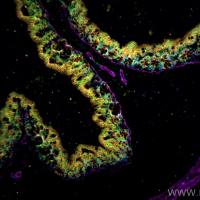Labeling DNA Damage with Terminal Transferase: Applicability, Specificity, and Limitations
互联网
514
Apoptotic and programmed cell death are characterized by, and indeed were first discovered from observations of, remarkable morphological changes that occur in the nucleus (see 1 for a comprehensive review of apoptosis and programmed cell death). Thus, light and electron microscopy were the first tools for the detection of apoptosis. This characteristic collapse of chromatin and ultimately the structural organization of the nucleus is triggered by the degradation of DNA, which is an active process and occurs prior to death of the cell. The degradation of DNA was subsequently found to be mediated by endonucleolytic activity that generated a specific pattern of fragments (2 ). The fragment sizes were multiples of approx 200 bp, the amount of DNA wound around a single nucleosome, and the pattern became known as the DNA ladder (Fig. 1A ). Later it became apparent that DNA fragmentation is quite variable within cells and some cell types produce only high molecular weight (HMW) fragments (Fig. 1B , 3 ). The latter observations formed the basis of a convenient in vitro biochemical technique for the routine detection of apoptosis by resolving the fragmented DNA by conventional or pulsed field agarose gel electrophoresis. However, this technique requires relatively large amounts of material and DNA extraction. Subsequently, a variety of techniques have emerged to detect apoptotic DNA fragmentation in situ by exploiting the fact that the hydroxyl group at the 5′ or 3′ ends of the small DNA fragments becomes exposed. Nucleotide analogues can be attached to the ends by several enzymes, with T erminal d eoxynucleotide T ransferase (TdT) being the most popular (4 ,5 ). The assays are typically fluorescence-based, either by the direct incorporation of a nucleotide to which a fluorochrome has been conjugated, or indirectly using fluorescent dye conjugated antibodies that recognize biotin- or digoxigenin-tagged nucleotides. Radioactively labeled nucleotides can also be used. Since several million fragments are generated during complete DNA fragmentation and low levels of fluorescence can be readily detected by photo-multipliers and CCD arrays, the assays are extremely sensitive. The assays have been formatted for light and confocal microscopy as well as flow cytometry, thereby greatly facilitating the detection and quantitation of apoptosis in situ . In addition, endlabeling techniques are employed in studies of the actual mechanism of DNA fragmentation, as well as the detection and characterization of endonucleases.









